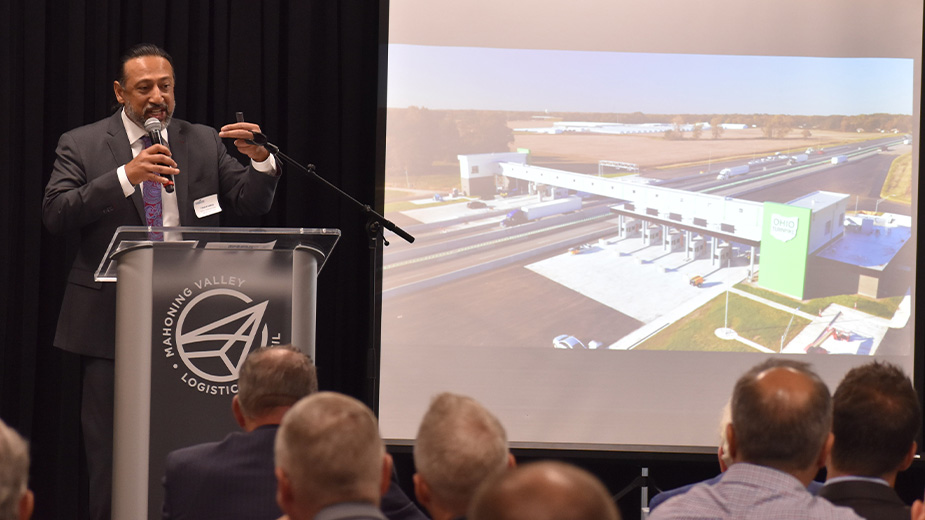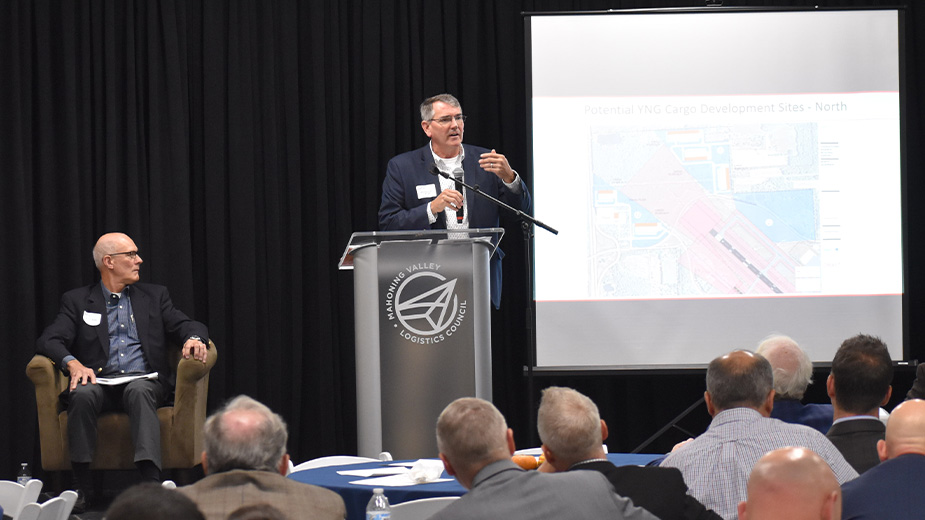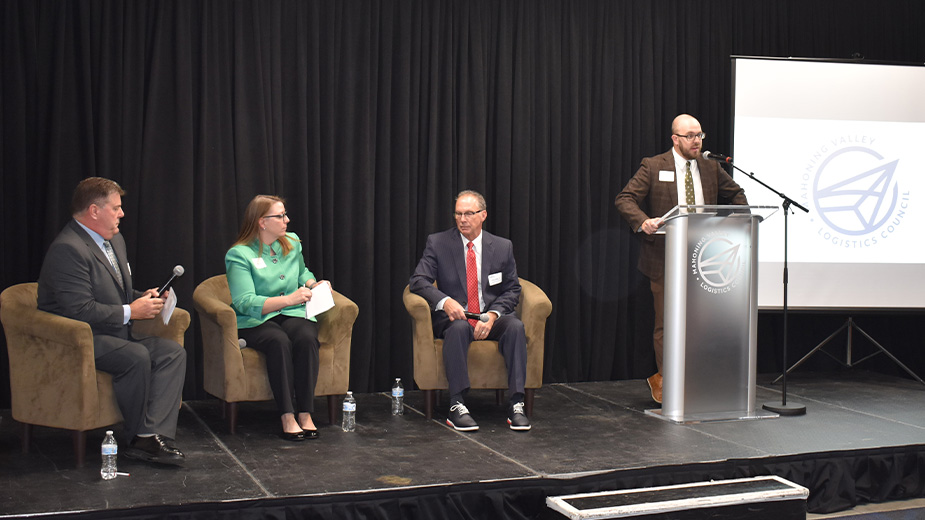Inaugural Conference Focuses on Logistics Issues
VIENNA TOWNSHIP, Ohio – Finding out as early as possible what businesses might need in terms of infrastructure improvements to enhance expansion would help public agencies put plans in motion to execute those improvements, participants in a panel focusing on transportation said.
The panel was among the programs held Thursday as part of the first Mahoning Valley Logistics Conference, a half-day event that took place at the Youngstown-Warren Regional Airport. It was presented by the Youngstown/Warren Regional Chamber’s Mahoning Valley Logistics Council.
“When we put together the Mahoning Valley Logistics Council, we were just trying to spread awareness that we don’t just work with trucking companies,” said David Wilaj, director of the council. “We work with everyone across the board. It covers a variety of industries.”
Topics addressed during the conference included infrastructure, the regional airport, Ohio Turnpike, trucking and the global supply chain.
“Whatever you need, we can make that happen. But what we don’t know, we don’t know,” said Jim Kinnick, executive director of Eastgate Regional Council of Governments. He participated on the event’s transportation panel with Trumbull County Engineer Randy Smith and Christina Wagner Schepis, program manager for the Ohio Department of Transportation office of jobs and commerce.
Smith discussed the collaboration that led to infrastructure improvements being initiated at the industrial area in Warren and Howland Township, known as the Golden Triangle. Those came about after local government entities met with local businesses and performed a needs assessment.
“Certainly, we weren’t assuming what the businesses needed. They brought that to our attention,” he said. “If we’re not aware of a project that may have an impact on our local infrastructure, sometimes it takes years for right of way, plan design and what have you, as many of you know. So if we truly don’t understand the needs of your business and you have an immediate need, it’s very difficult to get immediate attention.”
Kinnick urged businesses to reach out to the Regional Chamber regarding any infrastructure needs. Eastgate then can look for different funding sources for identified projects.
“Everybody’s working together on a unified vision in trying to help each other, and that’s the reason we’ve been moving forward more aggressively than we have in the past,” he said.
The Ohio Department of Transportation’s office of jobs and commerce was created to assist companies with infrastructure projects that are needed in time frames of 18 months or sooner, Schepis said.
The office has done about a dozen projects in Mahoning and Trumbull counties, she reported.
“You need to talk with your mayor. You talk to your council, township trustees, whoever your entity is, your political subdivision where your business is located, and just have a discussion,” Schepis said.
Among the projects on Eastgate’s agenda is studying the feasibility of an Interstate 80 interchange at state Route 304, Kinnick said. That not only would provide improved freeway access to residents of the East Side in Youngstown but also open available land there to development. Currently, 19% of the nation’s truck tonnage goes across I-80 through Youngstown.
The feasibility study should be complete in six to nine months, he said.
“When we talk to the chamber about all the leads they are getting, when it comes to business development and they’re looking for lands, they’re looking at the East Side,” he said.
Several companies are looking at land on the East Side, including tech giant Intel, which is spending $20 billion to develop two chip factories in central Ohio and has about 30 of the 100 companies in its supply chain looking there.
“The common denominator over there is access to the highway,” he said.

The Ohio Turnpike is one of the nation’s premier freight routes, and I-80 is the highest freight route in Ohio, said Ferzan Ahmed, executive director of the turnpike. Annually, 70 million tons of freight valued at $585 billion travels on the turnpike.
“That is projected to go up to $650 billion in 2024,” he added.
Average daily commercial traffic on the turnpike, as of 2022, was 35,155, compared with 35,098 in 2021, he reported. Class 5 five-axle tractor-trailers account for 25% of the turnpike’s traffic but 52% of its toll revenue.
He emphasized the importance of keeping tolls competitive to discourage drivers – commercial and otherwise – from using alternative routes. “We are committed to keeping our rates as low as long as we have enough revenue to take care of our system and keep it in a good condition,” he said.
Air cargo represents just 1% of the tonnage carried by all cargo operators but represents 35% of the value, said Russell Blanck, associate vice president of SPS Worldwide Aviation. “So what you’re looking at is very high value being transported on these little cargo operations,” he said. “So that’s very important in terms of the value that the client is putting into transporting that via an aircraft versus putting that on a truck.”

Mike Hillman, president and director of flight operations at Jets FBO, the airport’s fixed-base operator, said he has seen “very inexpensive items being shipped on what might be a $50,000 flight” because the lack of an item might be holding up a production line.
“It really is all about time,” he said.
He also sees cargo opportunities for the airport because other airports are running out of cargo capacity due to passenger counts rebounding.
“Some of the stuff I’m taking in here recently is Buffalo’s overwhelm. Some of it is related to local, but some of it is related to the fact that many of the larger airports that have been cargo centric over the years are overwhelmed because passenger counts are back up” he said.
A study of potential development opportunities at the regional airport is about three months from completion, said Greg Heaton, vice president and aviation business development lead for Crawford, Murphy & Tilly, airport aviation consultant. Before then, CMT will seek feedback to determine what else potential companies might want to know or what might be missing and adapt final recommendations accordingly.
“What we’ve been able to do is identify that there really are a tremendous amount of resources and assets out here at the Youngstown-Warren Regional Airport,” he said. But there is an “awareness issue.” Many companies are too busy to explore where might be a good spot to expand and determine if the area has a business-friendly environment. Getting that information out to “industry partners” that might be looking for a place to locate is a priority.
Pictured at top: David Wilaj, right, the logistics council’s director, speaks during the event. At left are Randy Smith, Trumbull County engineer, Christina Wagner Schepis, program manager for the Ohio Department of Transportation’s office of jobs and commerce, and Jim Kinnick, executive director of Eastgate Regional Council of Governments.
Copyright 2024 The Business Journal, Youngstown, Ohio.



